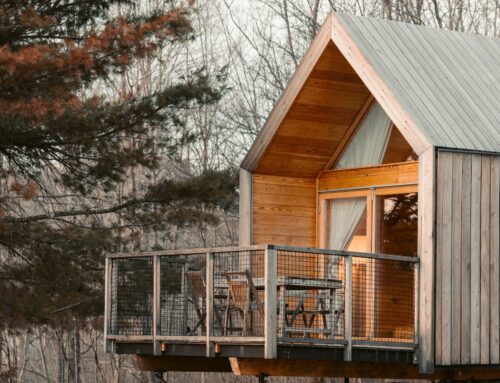Disclaimer: This information is intended for educational purposes only and is not financial advice. Always consult a financial professional before making a large borrowing decision.
A home equity line of credit (HELOC) is one of the most common ways to finance building an accessory dwelling unit (ADU) on your property. Lenders are increasingly offering this loan product as ADUs become more popular.
The amount of money you can get from a HELOC will determine your project budget, so it’s an important piece of information to learn early in the process. How much of a HELOC you can get to finance an ADU depends on how much equity you have built up in your home. However, there are also other factors to consider.
What Is a HELOC Loan?
HELOC is an acronym for “home equity line of credit.” As the name suggests, it is a loan that uses financial equity in your home as a line of revolving credit.
In this way, it is more similar to a credit card than a traditional mortgage. Rather than a loan of a set amount for one specific purpose, it is a revolving credit line that allows you to withdraw as needed. However, unlike a credit card, there is a time limit on when you can use this money known as the withdrawal period. Once this period ends, you enter the repayment period. During this time, you can no longer withdraw funds from the HELOC and can only make payments towards the debt.
Can I Get a HELOC?
To be eligible for a HELOC, you generally need to have at least 15% equity in your home. This means that you owe no more than 85% of what your home is worth on your mortgage. For example, if your home is worth $300,000, you must have at least $45,000 worth of equity built up.
You are also subject to many of the same requirements as traditional mortgages and other types of loans. Lenders will use your credit score, income, total revolving debt, and other information to determine your creditworthiness.
How Much Can I Get From a HELOC?
Most lenders will loan you up to 80% of the amount of equity you have in your home as a HELOC. Some lenders will loan you up to 90% of that value, but typically at much higher interest rates.
The key figure in determining how much HELOC you can get is called the loan-to-value (LTV) ratio. This is the amount of your outstanding loan compared to the value of your home. For example, if your home is worth $300,000 and you have paid $150,000 towards the principal on your mortgage, your LTV ratio is 50%. In this example, 80% of that equity would be $120,000.
How much you can get from a HELOC also depends on other factors like your credit score and how much revolving debt you have. The lower your credit score, the less a lender may be willing to loan you and the higher your interest rates will be. Lenders will also look at how much income you have left after meeting your revolving debt obligations from mortgage payments, car payments, and credit card payments. This is known as your debt-to-income (DTI) ratio. Lenders use this number to see how much of a HELOC payment you can afford each month.
How Much HELOC Can I Get Calculator
You can find calculator tools online that will tell you how much HELOC financing you are likely to get. These HELOC calculators ask you to input your home’s value, the balance of your loan, and your credit score at a minimum. Once you submit this information, they will give you an estimate of how much you may be able to borrow in the form of a HELOC.

Best HELOC Lenders For Investment Property
Not every lender offers HELOC as a loan product. And not every lender that offers HELOCs is a good choice for you.
Taking out a HELOC is a major financial decision and should be treated as such. Like with any major financial decision, it is important to shop around for a HELOC lender. You can find HELOC rates and terms advertised online. However, you will have to get a credit check to get your actual rates from a lender. Thankfully, you can now submit multiple credit checks in the same category in a short period of time without impacting your credit score more than you would with just one.
Best HELOC Lenders: What To Look For
The difference between a loan with good rates and conditions and one that is less favorable could easily be tens of thousands of dollars over the life of the loan. When shopping for a HELOC lender, there are a few things to consider:
- Interest rate: Your annual percentage rate (APR) is what determines how much you pay in interest over the life of the loan. Even a small difference in APR can work out to thousands of dollars by the end of the term.
- Rate structure: The APR you see advertised may not be the rate you pay for the full life of a HELOC. Some are introductory rates that may go up after an initial period. Make sure you understand whether the rate you see advertised is fixed or just an introductory rate subject to an increase in the future.
- Prepayment fees: Some lenders charge you a fee to pay off your HELOC early. If you want to use your ADU as a rental, for example, you may make enough money off of it to pay your HELOC off before the full term is up. But not all lenders charge a prepayment fee, so check the fine print to see if the lender you’re considering does or not.
- Other fees: Some lenders charge more fees than others. When you take out a HELOC, you’ll have to pay a loan origination fee with nearly every lender. However, some lenders may charge fees for things like certain paperwork or late payments. These fees can add up, so it’s worth understanding all of the costs involved in your HELOC.
How Much HELOC Can I Get? Conclusion
The biggest factor in how much you can get from a HELOC is the amount of equity you have in your home. But other factors, such as your credit score and your DTI ratio also play a role. Rates, requirements, and costs vary between lenders. That’s why it’s important to shop around to find the best HELOC offer for you and your ADU project.
We know that financing can be a stressful part of the ADU building process. To help our customers, we offer referrals to some of our trusted partners who have helped many of our customers in the past. You can and should research your lending options, but we are happy to help make the process a little more smooth to take some of the stress and anxiety out of the process.






Leave A Comment